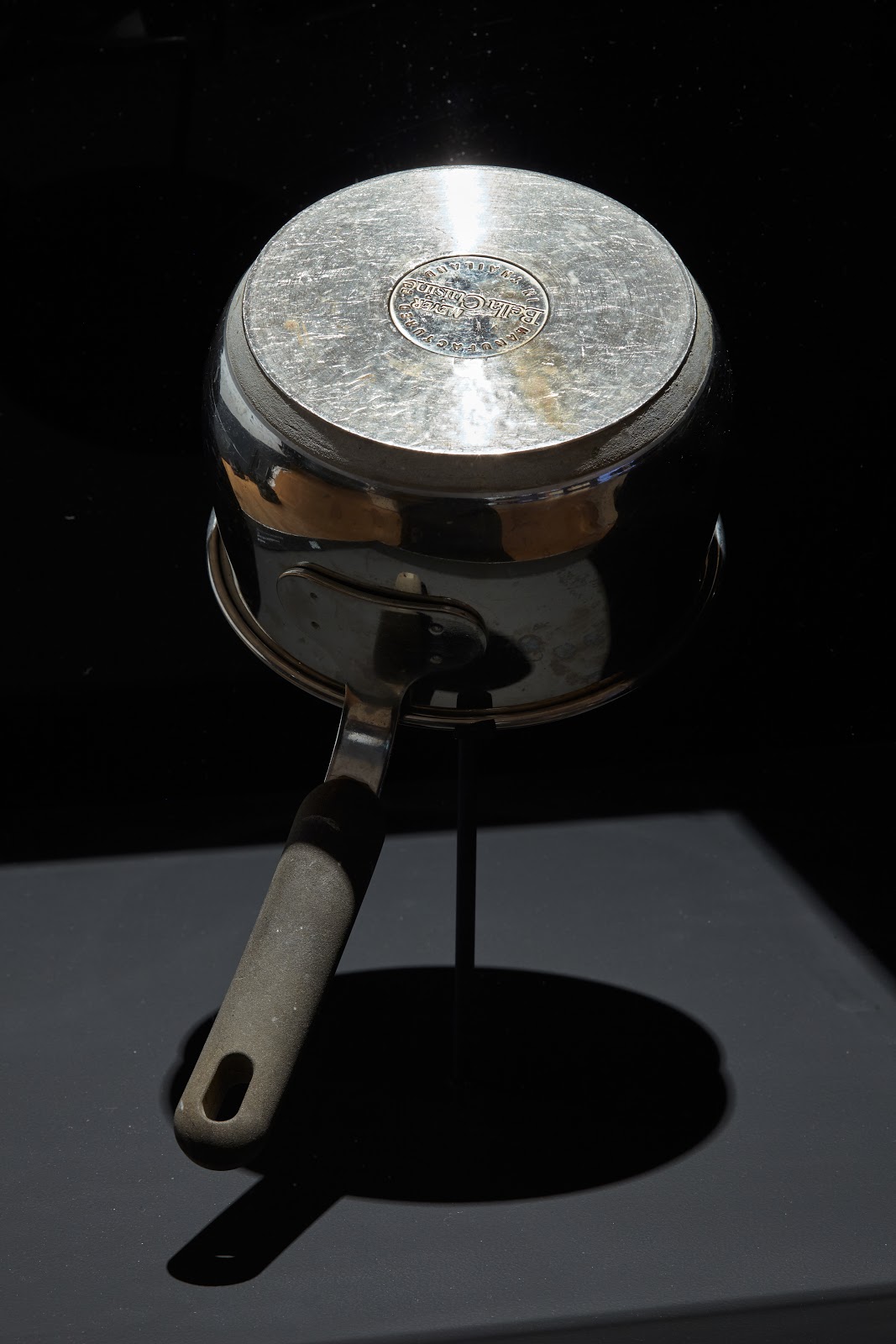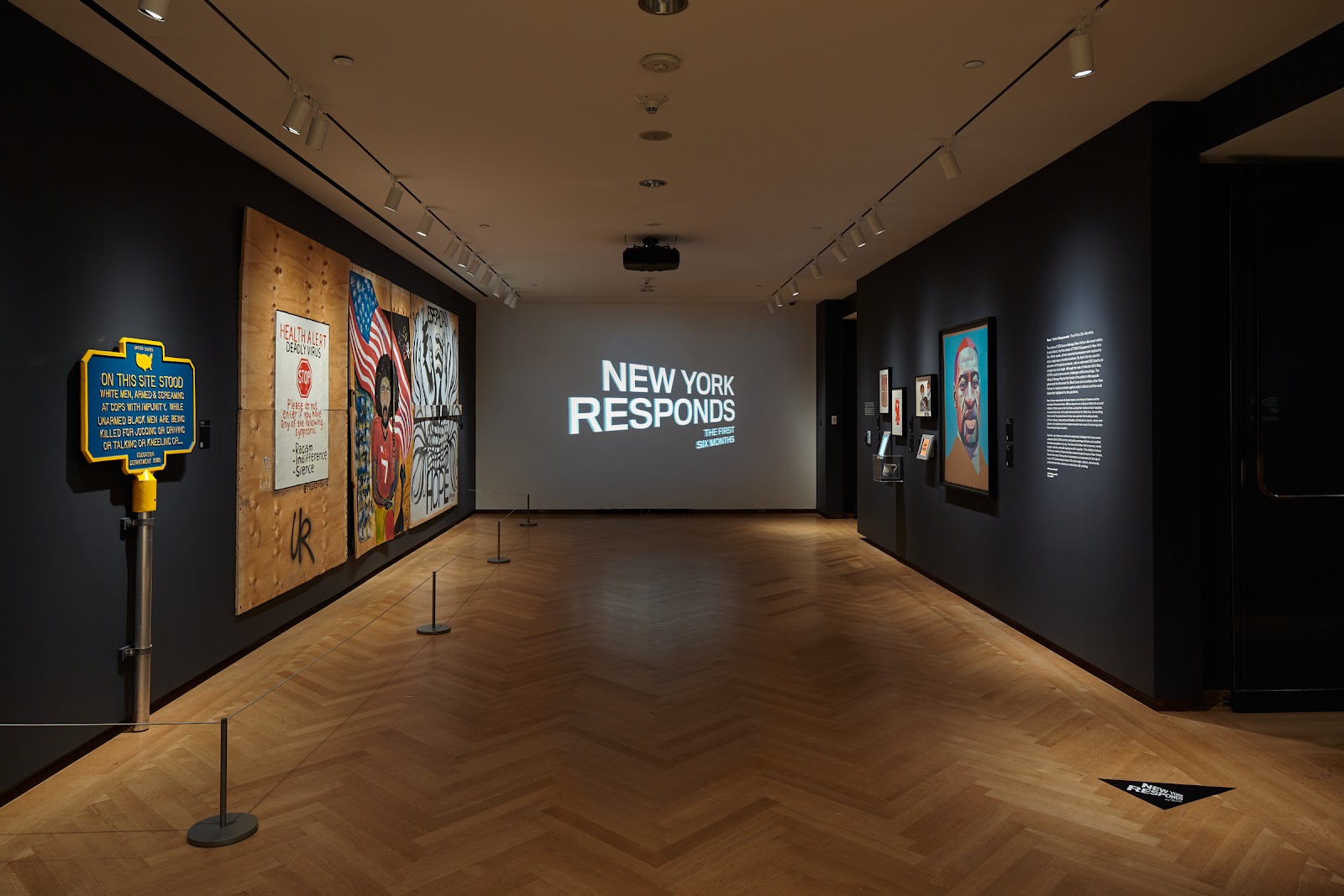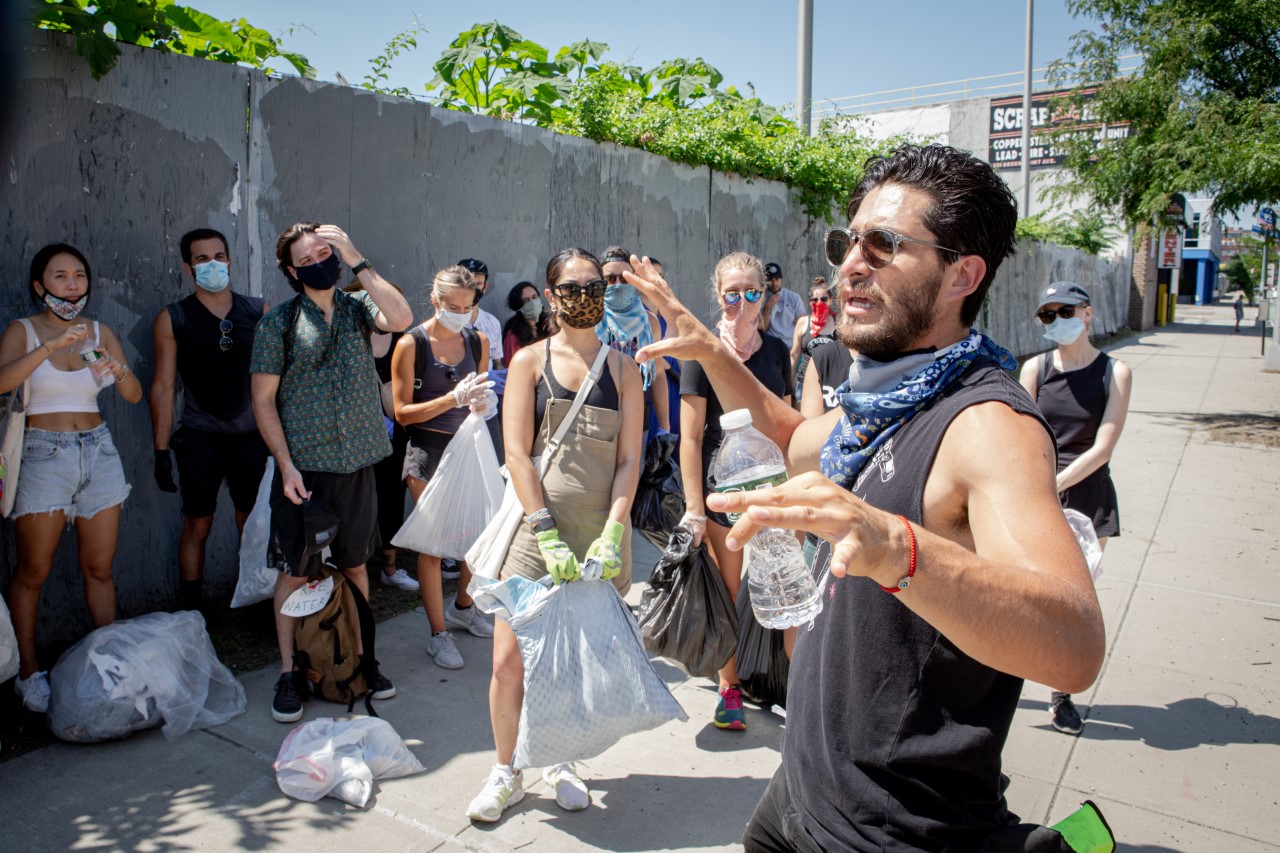There is a saucepan that is slightly dented from the nightly 7 o’clock clapping sessions to thank the health care workers in New York City during the COVID-19 pandemic. The pan was one of the first objects included in the Museum of the City of NY’s New York Responds exhibition. More than 20,000 objects, photographs, artworks, and stories were submitted through the Museum’s open call for items that help to reflect on the changes and challenges of life in New York City from March through August 2020. These items document and interpret the COVID pandemic, the uprising for racial justice, and how New Yorkers fought to cope, survive, and build a better future.
 Inside the main exhibition space. Photograph by Brad Farwell, courtesy of the Museum of the City of New York
Inside the main exhibition space. Photograph by Brad Farwell, courtesy of the Museum of the City of New York
Rapid Response
“We wanted to start quickly,” said Sarah Henry, Deputy Director and Chief Curator for the Museum of the City of NY. “It was important for us to document for the future and also play a role of service in the crisis itself.” The Museum has been collecting for almost 100 years and has done public and responsive collecting before, including open calls for exhibition objects around historical and contemporary events like Hurricane Sandy, Occupy Wall Street, and September 11.
On July 23, MCNY unveiled the first phase of New York Responds, an outdoor installation featuring 14 images that were submitted as part of ongoing collecting efforts. This outdoor exhibition captured the early days of the pandemic and the Black Lives Matter protests. “There was a powerful sense when we were creating the first phase of this exhibition,” said Henry. The Museum built upon the outdoor installation in the summer to open the full exhibition in December. “We included a phrase on the outside of the building, ‘history is happening now’ and it was palpable that this was living history and a moment like no other.”
Collecting and Exhibiting
There were two parallel processes: collecting for the Museum’s permanent collection and selecting items for the exhibition. Lindsay Turley, Vice President of Museum Collections, wrote the collecting plan and led the museum’s collecting efforts to review crowdsourced items and targeted outreach. “We were accepting submissions not only through the open call but also through email,” said Henry. “[Turley] contacted people and other institutions about offering items for the collection.”
As Chief Curator, Sarah Henry planned the exhibition with her curatorial team and reviewed the items that Turley was accessioning into the museum collection or considering. “Separately, my colleagues and I went through the submissions from the open call. At the end it was a combination of items that were solicited for the collection or in some cases had been promised gifts. We also borrowed and licensed materials that were not being considered for the collection, including my team approaching artists about lending for the exhibition.” Both processes intersected with one another but the selection for either the museum collection or for inclusion in the exhibition remained independent.

A pan used during the nightly 7 o’clock clapping for healthcare professionals. Meyer Corporation, c. 2015, Museum of the City of New york. Gift of Majorie Rothenberg, 2020.16.1. Courtesy of the Museum of the City of New York. Photography by Brad Farwell.
Open Call
In addition to objects that were nominated through the open call, more than 18,000 posts were submitted using the hashtag #COVIDStoriesNYC and more than 5,000 using #ActivisitNY on Instagram. “We had our marketing and communications team work with our photography curator and social activism curator to help monitor and review these hashtags throughout the year,” said Henry. Marketing and Communications and curatorial staff selected highlights to re-post on the Museum’s social media channel. Curatorial staff also monitored the hashtags to either include them into the collection or for consideration for the exhibition.
Among the photos that made it into the exhibition is of a window, full of toilet paper rolls titled “Toilet Paper Hoarder” submitted by photographer Ruben Natal-San Miguel. Another is a photograph of the question, ‘what is essential?’ graffitied onto the side of a wall captured by Russ Rowland. Included in the exhibition are the photographer’s reflection who recalled how strange it was to see how few people were outside despite it being a beautiful day. “It was a people-less vision of NYS I’ve only seen during snowstorms in the middle of the night. It was strange, and kind of a delight.”
 Ruben Natal-San Miguel, Toilet Paper Hoarder, Manhattan, NYC 2020
Ruben Natal-San Miguel, Toilet Paper Hoarder, Manhattan, NYC 2020
Courtesy of the photographer
There were physical objects too that were submitted including a COVID pinata.“Early in the pandemic the New York Times posted instructions of how to make a pinata of the COVID virus to bash at home,” said Henry. Material items like these reflected on how New Yorkers endured and coped with the pandemic. “Coping became one of the themes of the exhibition.”
Masks were also submitted and included in the exhibition. “Masks became a big interest and so for the exhibition we were able to represent artistic uses of masks as pieces of self expression and personal protective equipment.” There is an N95 mask from the collection of the Mount Sinai Health System and a hot dog face mask. The hot dog face mask was a People’s Choice Award winner at Maskie Awards in Coney Island, and was donated to the Museum’s permanent collection by Suzie Sims-Fletcher.
 Masks on display [far left] an “Enough Is Enough” face mask, –Sheila Stainback / CAMBA [bottom] a face mask used by counselors for the Greenwich House Methadone Maintenance Treatment Program, courtesy of Sally Young/Greenwich House [top] Suzie Sims-Fletcher, the HOT DOG! Mask- Gift of the artists; and [far right] N95 face mask from the Mount Sinai Health System Collection. Photograph by Brad Farwell, courtesy of the Museum of the City of New York
Masks on display [far left] an “Enough Is Enough” face mask, –Sheila Stainback / CAMBA [bottom] a face mask used by counselors for the Greenwich House Methadone Maintenance Treatment Program, courtesy of Sally Young/Greenwich House [top] Suzie Sims-Fletcher, the HOT DOG! Mask- Gift of the artists; and [far right] N95 face mask from the Mount Sinai Health System Collection. Photograph by Brad Farwell, courtesy of the Museum of the City of New York
Three plywood artworks were loaned to the museum for the exhibition.These were part of a massive art project launched by Art 2 Heart and SoHo Social Impact, transforming the neighborhoods of SoHo and NoHo into an “open-air museum.”
 Entrance to the exhibition. On the left hand side you can see the three plywood artworks on loan to the museum. Photograph by Brad Farwell, courtesy of the Museum of the City of New York
Entrance to the exhibition. On the left hand side you can see the three plywood artworks on loan to the museum. Photograph by Brad Farwell, courtesy of the Museum of the City of New York
Items like hand sanitizer produced from a Brooklyn distillery illustrated the different ways that manufacturing pivoted to provide materials. “There’s an improvised ventilator made from a respirator by medical personnel at The Mount Sinai Health System that reflected things that medical personnel had to do in order to do their jobs and serve the people affected by the crisis,” said Henry. “Items like these were sometimes mundane in their physical appearance but powerful in the stories they captured.”
 Above is the improvised ventilator made from a respirator by medical personnel at The Mount Sinai Health System. Photograph by Brad Farwell, courtesy of the Museum of the City of New York
Above is the improvised ventilator made from a respirator by medical personnel at The Mount Sinai Health System. Photograph by Brad Farwell, courtesy of the Museum of the City of New York
Targeted Outreach
“We tried to be open minded about the criteria in order to see what themes were emerging,” said Henry. “As people were submitting, we began to create a rubric of what was being brought forward and began to see patterns. When we saw people nominating things in a certain genre, we wanted to make sure it was represented in the exhibition.” Some themes like “Art as Response” and “Masks” emerged organically, others like “Mutual Aid” that focuses on New Yorkers who launched initiatives to help their communities during the pandemic and “The New Normal” that illustrated empty streets and playgrounds, required more targeted outreach.
 Sébastien Vergne[In the absence of city resources, volunteers from the community group Echoed Voices clean up their Greenpoint neighborhood] July 2020
Sébastien Vergne[In the absence of city resources, volunteers from the community group Echoed Voices clean up their Greenpoint neighborhood] July 2020
Courtesy of the photographer
“We created a concept document of what were the stories that we wanted to make sure were represented so we could then do further outreach and make sure there were materials representing those stories even if it hadn’t come through the open call,” said Henry.
The Museum invited a jury of twelve people to make selections and recommendations for the exhibition. Jury members represented a range of backgrounds and perspectives of the city from across the five boroughs.
“We wanted to keep it [the jury] small so that they could really talk qualitatively with each other and just have a voting process with a majority rule,” said Henry. “We wanted jury members to have a substantive conversation.” The jury also looked for what was missing.
“We would use their comments to go out and look for other materials to tell stories that they felt should be represented but weren’t present from the crowdsourced items,” said Henry. During the first meeting, the jury discussed issues such as the demonstration at City Hall that felt very iconic. “So we went back into the social media streams to look for materials that captured that moment.”
Other things like portraits of essential workers did not emerge from the open call. “We did a targeted outreach to fill that gap. It was kind of like a dialectic process between following the crowd sourced materials and letting themes emerge organically versus identifying thematic gaps in what people were bringing forward but were still important to include. People definitely gravitate to certain kinds of images to share on social media but there were other things happening in the city that people weren’t thinking of to submit.”
Moving Forward
The Museum of the City of NY made the exhibition available online in its entirety. It is organized into 19 thematic sections including an interactive timeline. “The timeline originally covered the first six months and was only available to those who visited the exhibition,” said Henry. The timeline, curated by Azra Dawood, the Museum’s Andrew W. Mellon Foundation Postdoctoral Curatorial Fellow, was expanded to capture the entire year and can be viewed on the museum’s website. “It weaves together the stories of COVID and the movement for Black lives in a powerful way.” More than a year after the pandemic began, the Museum continues to mark important anniversaries.
 Francesca Magnani [Juneteenth protest crossing the Brooklyn Bridge] June 19, 2020
Francesca Magnani [Juneteenth protest crossing the Brooklyn Bridge] June 19, 2020
Courtesy of the photographer
The Museum continues to collect stories through an oral history project in partnership with StoryCorps that allows people to submit their experiences online. Stories are saved at StoryCorps archive at the American Folklife Center at the Library of Congress.
“We know that this is a really important story for our city and the world where central characteristics of urbanism were brought into question,” said Henry. “The Museum of the City of NY is dedicated to the past, present and future of the five boroughs of NYC and urbanism. We know that we are going to be contending with the repercussions of these events for years to come.”
Explore New York Responds online: https://www.mcny.org/new-york-responds-online
